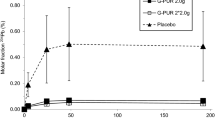Abstract
The aim of the study was to examine whether plasma exchange (PE) or selective double filtration plasmapheresis (DFPP) is able to reduce the internal Polychlorinated biphenyl (PCB) burden of highly exposed participants of the health effects in high-level exposure to PCB (HELPcB) cohort. HELPcB is a surveillance program for former PCB-exposed workers of a German capacitor recycling company. After comparative evaluation of PE and DFPP in a phase I, DFPP was chosen as method for further treatment. In phase II, five participants underwent DFPP at weekly intervals for the duration of 12 weeks. Six PCB species were selected as indicators and were analyzed in the plasma before and after each treatment and 4 weeks after the last treatment. The PCB levels before and after each DFPP treatment showed a significant reduction in PCB blood levels; however, there was no significant change in PCB levels within the samples collected before each treatment as compared with the samples collected in the following week before treatment. Even the difference between PCB levels at the onset of the study and 4 weeks after the last treatment was not significant. The results of this pilot trial do not encourage further investigations in using therapeutic apheresis to reduce the PCB body burden.
This is a preview of subscription content, access via your institution
Access options
Subscribe to this journal
Receive 6 print issues and online access
$259.00 per year
only $43.17 per issue
Buy this article
- Purchase on Springer Link
- Instant access to full article PDF
Prices may be subject to local taxes which are calculated during checkout




Similar content being viewed by others
References
Carpenter DO, Arcaro KF, Bush B, Niemi WD, Pang S, Vakharia DD . Human health and chemical mixtures: an overview. Environ Health Perspect 1998; 106 (Suppl 6): 1263–1270.
Seegal RF, Fitzgerald EF, Hills EA, Wolff MS, Haase RF, Todd AC et al. Estimating the half-lives of PCB congeners in former capacitor workers measured over a 28-year interval. J Expo Sci Environ Epidemiol 2010; 21: 234–246.
Ritter R, Scheringer M, MacLeod M, Moeckel C, Jones KC, Hungerbuhler K . Intrinsic human elimination half-lives of polychlorinated biphenyls derived from the temporal evolution of cross-sectional biomonitoring data from the United Kingdom. Environ Health Perspect 2011; 119: 225–231.
Schettgen T, Alt A, Preim D, Keller D, Kraus T . Biological monitoring of indoor-exposure to dioxin-like and non-dioxin-like polychlorinated biphenyls (PCB) in a public building. Toxicol Lett 2012; 213: 116–121.
Kilburn KH, Warsaw RH, Shields MG . Neurobehavioral dysfunction in firemen exposed to polycholorinated biphenyls (PCBs): possible improvement after detoxification. Arch Environ Health 1989; 44: 345–350.
Jandacek RJ, Heubi JE, Buckley DD, Khoury JC, Turner WE, Sjodin A et al. Reduction of the body burden of PCBs and DDE by dietary intervention in a randomized trial. J Nutr Biochem 2014; 25: 483–488.
Schettgen T, Gube M, Esser A, Alt A, Kraus T . Plasma polychlorinated biphenyls (PCB) levels of workers in a transformer recycling company, their family members, and employees of surrounding companies. J Toxicol Environ Health A 2012; 75: 414–422.
Kraus T, Gube M, Lang J, Esser A, Sturm W, Fimm B et al. Surveillance program for former PCB-exposed workers of a transformer and capacitor recycling company, family members, employees of surrounding companies and area residents – Executive summary. J Toxicol Environ Health Part A 2012; 75: 1241–1247.
Wittsiepe J, Wilhelm M, Kraus T . Levels of polychlorinated dibenzo-p-dioxins and dibenzofurans (PCDD/F) in blood samples of occupationally exposed workers from a transformer recycling plant in Dortmund, Germany-initial findings. J Toxicol Environ Health A 2012; 75: 423–428.
Weinstein R . Phytanic acid storage disease (Refsum's disease): clinical characteristics, pathophysiology and the role of therapeutic apheresis in its management. J Clin Apher 1999; 14: 181–184.
Heibges A, Bunia J, Kalb K, Wagner S, Zolotov D, Fuechtemann D et al Lipid apheresis for the long-term treatment of Refsum's disease. Saturday, 26 June 2010. Poster Session 1. NDT Plus. 2010; 3(Suppl 3): iii143.
Straube R, Gackler D, Thiele A, Muselmann L, Kingreen H, Klingel R . Membrane differential filtration is safe and effective for the long-term treatment of Refsum syndrome—-an update of treatment modalities and pathophysiological cognition. Transfus Apher Sci 2003; 29: 85–91.
Zolotov D, Wagner S, Kalb K, Bunia J, Heibges A, Klingel R . Long-term strategies for the treatment of Refsum's disease using therapeutic apheresis. J Clin Apher 2012; 27: 99–105.
Julius U, Metzler W, Pietzsch J, Fassbender T, Klingel R . Intraindividual comparison of two extracorporeal LDL apheresis methods: lipidfiltration and HELP. Int J Artif Organs 2002; 25: 1180–1188.
Klingel R, Mausfeld P, Fassbender C, Goehlen B . Lipidfiltration—-safe and effective methodology to perform lipid-apheresis. Transfus Apher Sci 2004; 30: 245–254.
Federal-Environmental-Agency. Stoffmonographie PCB –Referenzwerte für Blut. In: Bundesgesundheitsblatt Umweltbundesamt Umweltbundesamt 1999; p 511–21.
Wang RY, Jain RB, Wolkin AF, Rubin CH, Needham LL . Serum concentrations of selected persistent organic pollutants in a sample of pregnant females and changes in their concentrations during gestation. Environ Health Perspect 2009; 117: 1244–1249.
Schettgen T, Gube M, Alt A, Fromme H, Kraus T . Pilot study on the exposure of the German general population to non-dioxin-like and dioxin-like PCBs. Int J Hyg Environ Health 2011; 214: 319–325.
IBM-Corporation. IBM SPSS V23 Statistics for Windows. Version 23 ed. Armonk, NY, USA. 2015.
OriginLab-Corporation. Origin. 6.0 ed. 1999, Northampton, M.A, http://www.originlab.com/index.aspx?go=Support&pid=450.
Schmider E, Ziegler M, Danay E, Beyer L, Buehner M . Is It really robust? reinvestigating the robustness of anova against violations of the normal distribution assumption. Methodology 2010; 6: 147–151.
Moriarty PM, Hemphill L . Lipoprotein apheresis. Cardiol Clin 2015; 33: 197–208.
Artacho-Cordon F, Fernandez-Rodriguez M, Garde C, Salamanca E, Iribarne-Duran LM, Torne P et al. Serum and adipose tissue as matrices for assessment of exposure to persistent organic pollutants in breast cancer patients. Environ Res 2015; 142: 633–643.
Kodavanti PR, Ward TR, Derr-Yellin EC, Mundy WR, Casey AC, Bush B et al. Congener-specific distribution of polychlorinated biphenyls in brain regions, blood, liver, and fat of adult rats following repeated exposure to Aroclor 1254. Toxicol Appl Pharmacol 1998; 153: 199–210.
Acknowledgements
All research based on HELPcB data is part of an agreement between the Institute for Occupational Medicine and Social Medicine, RWTH Aachen University, Germany and the Institution for Statutory Accident Insurance and Prevention in the Energy, Textile, Electrical, and Media Industry (BGETEM), Cologne, Germany with regard to conducting the surveillance and research program. The views expressed in this publication are those of the authors and do not necessarily correspond to those of the BGETEM. Preliminary findings were presented at the 56th Scientific Meeting of the German Society for Occupational and Environmental Medicine in München (Germany) on 10th March 2016. This project was funded by the Institution for Statutory Accident Insurance and Prevention in the Energy, Textile, Electrical, and Media Industry (BGETEM), Cologne, Germany. (Unrestricted grant to the University Hospital Aachen, RWTH Aachen University, grant number 360328).
Author information
Authors and Affiliations
Corresponding author
Ethics declarations
Competing interests
The authors declare no conflict of interest.
Rights and permissions
About this article
Cite this article
Gube, M., Schettgen, T., Kraus, T. et al. Use of plasma exchange or double filtration plasmapheresis to reduce body burden of polychlorinated biphenyls: A pilot trial. J Expo Sci Environ Epidemiol 27, 444–450 (2017). https://doi.org/10.1038/jes.2016.37
Received:
Accepted:
Published:
Issue Date:
DOI: https://doi.org/10.1038/jes.2016.37



